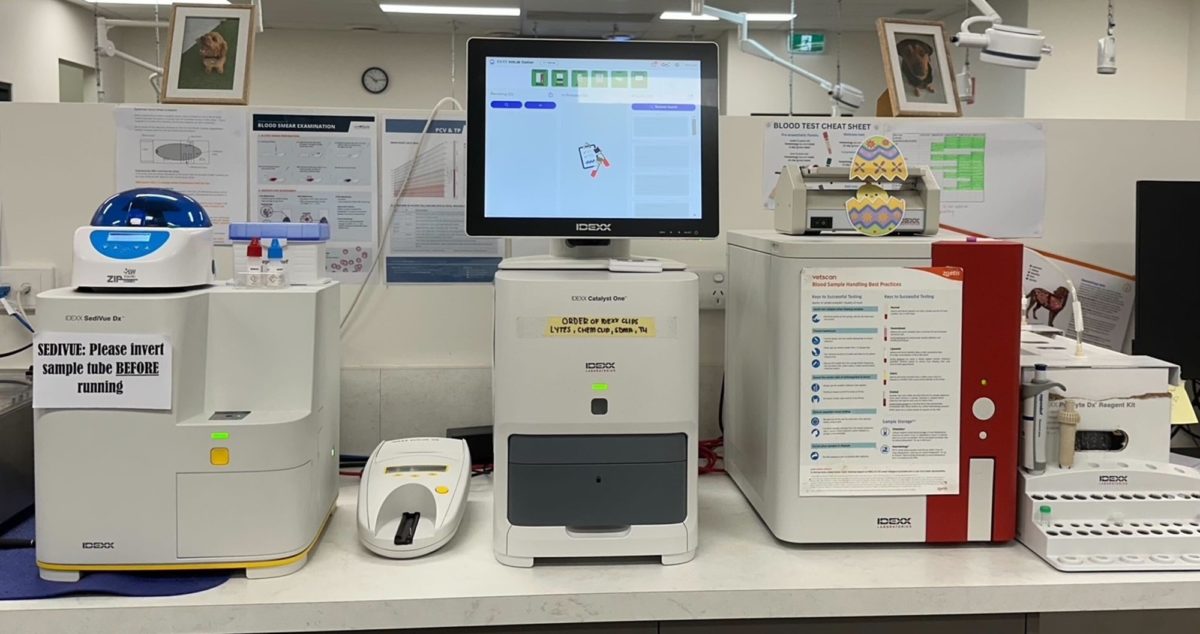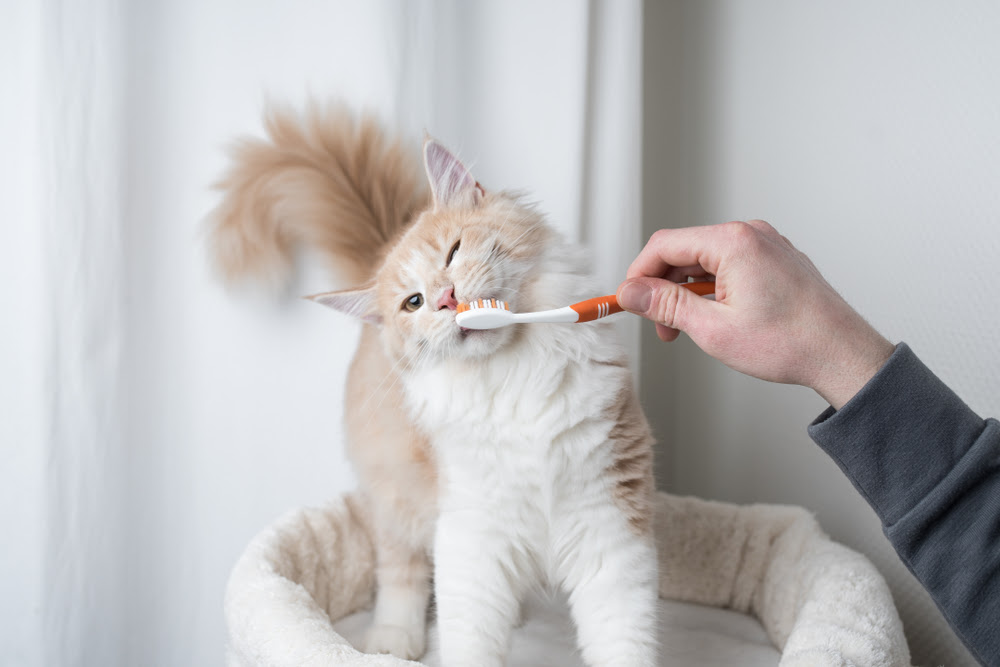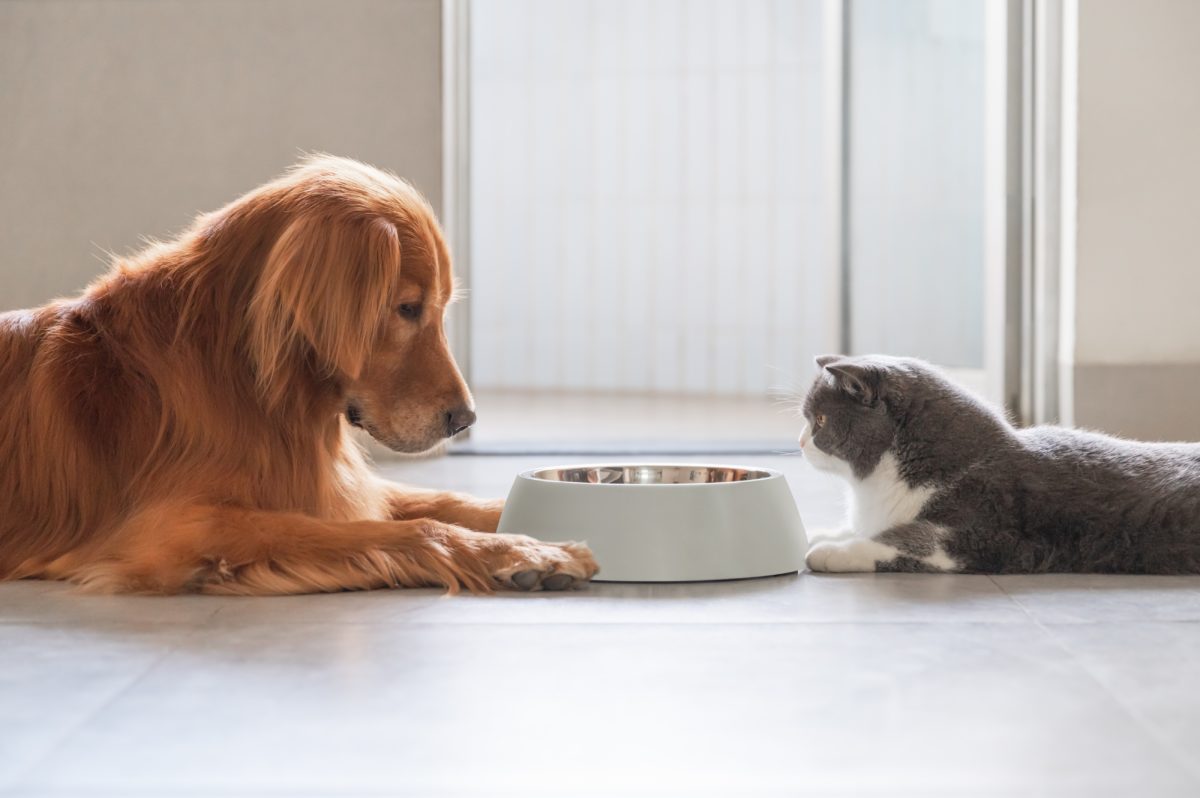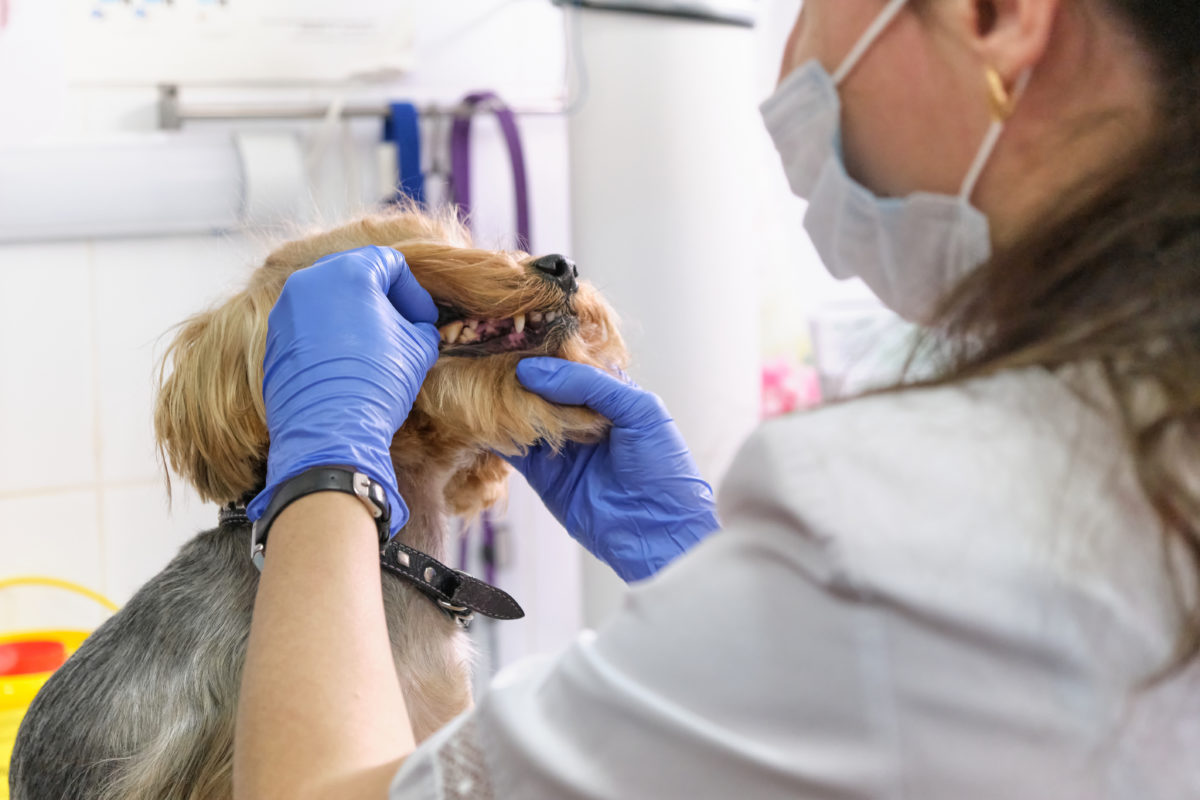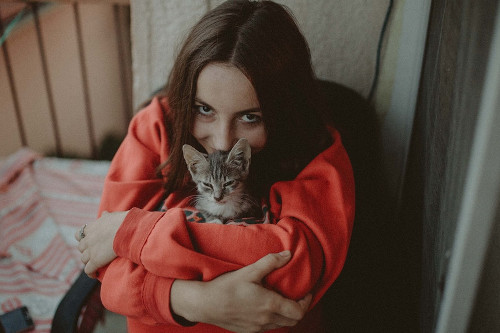Annual blood tests are a vital part of your pet’s healthcare routine, providing a baseline for comparison, enabling early detection of health issues, and uncovering hidden conditions before they become serious. From spotting early signs of disease to ensuring safe anaesthesia during procedures, regular bloodwork helps your pet live a longer, healthier life. Learn why prevention through routine testing is key to your pet’s well-being.
Discover how to choose the best food for your pet with this comprehensive guide. Learn about age-specific diets, dry vs. wet food, and how to monitor your pet's health through nutrition. Ensure your furry friend stays happy and healthy!
As Easter nears, we look forward to celebrating with family, seeing friends and of course, delicious treats. However, it’s important to remember the risks these goodies can pose to our furry friends, as they can be toxic foods for dogs and cats.
Dogs and Chocolate:
It’s no secret that chocolate is a hazard to a dog’s health. Chocolate contains substances like theobromine and caffeine, harmful to dogs when ingested in large amounts. Additionally, the colourful wrappers on lollies can also be hazardous if swallowed, potentially causing gastrointestinal issues and might even require a visit to an emergency vet.
While chocolate is widely known to be harmful to dogs, it’s important to note that cats are also at risk. Therefore, it’s crucial to keep all chocolates out of reach of both dogs and cats to prevent any potential health issues associated with cats and chocolate ingestion.
You can keep your pets healthy by:
- Storing chocolates and lollies out of reach.
- Let guests know about the dangers to pets.
- Dispose of wrappers properly.
- Offer safer alternatives for dogs to occupy themselves with like dog toys and treats.
Candy Wrappers and Your Dog’s Health
But it’s not just the toxic food for dogs itself that can pose a threat, the colourful wrappers can also be harmful when ingested. One way to notice this happening is your pet breathing heavily.
The sharp edges of the foil on wrappers pose another danger to dogs, such as tearing or puncturing the digestive tracts that might require an emergency visit to the vet.
Pet Holiday Stress
All the excitement around the easter period can be exciting, but can also be anxiety inducing and lead to a very stressed dogs and cats.
It’s good to remember that, like us, dogs and cats can be overwhelmed too, and that puppies and kittens can experience stress too. So during the easter holidays, your pets will thank you for checking in on them particularly when their normal environment is being invaded by unfamiliar people, which will mean you’ll have a much less stressed pet..
Easter Plants and Flowers:
Easter is a time for flowers aplenty, with lilies and daisies being some of the most popular during easter celebrations. However, for cats, lilies are particularly harmful, all parts of the lily plant contain toxins that can cause severe damage if eaten.
Symptoms of a cat eating lily flowers include:
- Vomiting
- Loss of appetite
- Lethargy
What to do if your Cat or Dog is Unwell
Contact Clyde vet or us immediately for guidance if you believe your cat or dog has eaten poisonous foods or is displaying any of these symptoms. Certain situations, such as a pet ingesting toxic foods or displaying alarming symptoms like your pet breathing heavily, may necessitate an immediate visit to an emergency vet for quick treatment.
Acting quickly can be crucial for a successful recovery, so don’t hesitate to get help if you have concerns about your cat or dog’s health.
Pet Toxic Food Treatment at Clyde Veterinary Hospital
You can trust our team of experienced vets to look after your pet if they’ve ingested harmful food or plants. Give our team a call on (03) 9052 3200 or make a booking online to get started.
Giving your furry friend the best chance at living a longer, healthier life is the goal of every loving pet owner. Doing what’s best for your pet goes beyond ensuring they have access to good food, water & a comfortable environment.
Dental health care is often overlooked in pets and is of critical importance for their health & wellbeing. Did you know up to 85% of dogs or cats experience some form of dental health issue by just 3 years of age?
National pet dental health month is the perfect reminder of why it’s important to look after your pet’s teeth and gums. By recognising the signs of dental disease and taking steps to prevent it, you can help improve the quality of life for your pet for the years to come.
Recognising dental disease in pets: what is it and what does it look like
So why are teeth and gums so important to look after and what happens if they are not looked after?
Most dogs, cats and pocket pets are not born with bad teeth. In actual fact most young pets teeth will look clean, white and quite unremarkable. This can often be misleading because this may instil a false sense of security in pet owners; you may then ask yourself “My pets teeth are perfect, why should I bother to clean them”?
What is important to remember is that without regular brushing and possible dental heath care products (if required) over a period of month to years teeth WILL slowly accumulate plaque, followed by tartar with associated gingivitis.
A healthy mouth
A healthy pet’s mouth should show gums of a uniform light pink colour, with clear white teeth showing no discolouration or build up of plaque around the gums.
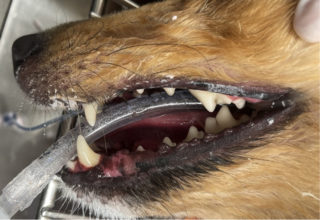
What is plaque?
Plaque is the first stage of dental disease and in animals is the pale yellow, light tan grimy film layer that coats the surface of teeth. Dogs, cats, pocket pets (and yes even humans!) that do not brush their teeth will accumulate this layer in a matter of hours. The composition of plaque itself is a mixture of microscopic food particles, saliva, oral bacteria, and minerals.
Plaque can in its earliest presentation be removed with regular toothbrushing. However if it is allowed to continue without proper dental care and removal it can form tartar.
This stage of dental disease is the most reversible and easiest to treat.
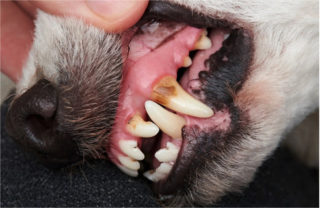
What is tartar?
Tartar is the next step in dental disease after plaque. It is plaque that has mineralised (calcified). Tartar can over time form continual layers on teeth and reach below the gum line to sit in the tooth socket. Tartar looks like a thickened brown film on the teeth with a craggy / raised ‘mountainous’ appearance. Because tartar is mineralised (and therefore very hard) it is not as amenable to tooth brushing for removal.

What is Gingivitis?
Once plaque and tartar are established on teeth and at the tooth / gum margin gingivitis will worsen. Gums are very sensitive tissues and chronic exposure to oral bacteria in plaque and tartar will cause a lot or redness, tenderness, inflammation, prone to bleeding with associated pain. It should also be remembered that red swollen, infected gums are more permeable to oral bacteria; which means that there is a higher chance of oral bacteria being absorbed into the bloodstream.
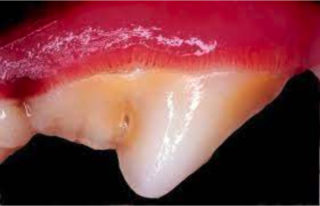
Tissues that can form bacterial inflammatory deposits include kidney and cardiac tissue. This may result in continual disease in these organs (example; kidney dysfunction or infections) or recurrent periods where your pet is unwell and “just not right”. The longer the dental disease continues untreated the more sickness episodes can be expected in our furry friends.
What happens with continual untreated dental disease?
End stage Periodontal Disease: Infected and loose teeth
Over time continual exposure of teeth and gums to bacteria will slowly erode the supporting ligament that holds teeth in place (the periodontal ligament); in time teeth will loosen and become mobile (wobbly) in their bony sockets. This increased gap in the space in-between the tooth and its socket allows further bacteria to sit in this space and accumulate.
In time the end stage of dental disease or “tooth decay” will become evident as teeth with pus around the gum / tooth margin with wobbly teeth that move whenever the pet eats.
Eventually the bony sockets of the upper and lower jaw that the teeth sit in become infected (osteomyelitis) with the bone changing into a more softer and fragile consistency.
Once the gums, teeth and mouth reach this later stage of dental disease it is often irreversible: meaning that dental cleaning and prophy treatments are recommended and instigated but these will not restore the teeth back to complete health and ongoing dental disease is expected in the future requiring ongoing care.
As expected this final stage of dental disease can be quite painful and reduce eating due to pain. Additionally brushing the teeth becomes more difficult due to the increased sensitively of the teeth to pain.
While plaque and tartar can often be seen by looking in your pet’s mouth, sometimes it can be hard to notice when you’re unsure what to look out for. As a general rule, don’t assume that your pet’s teeth are healthy without getting a pet dental health check and maintaining pet dental care.
Here are some common signs of dental disease:
- Bad breath
- Irregular/abnormal eating or drinking: eg. picking up food with their nouth then dropping it
- Broken/loose teeth
- Excessive drooling or pawing at mouth
- Bleeding from the mouth
- Teeth that are no longer white on the surface but are yellow or tan with a rough texture rather than a soothe surface
Benefits of Maintaining Pets Dental Health
By getting to it early, you minimise the likelihood of tartar forming and moving below the gum line and causing your pet serious pain and discomfort as a result of inflammation and infection.
Ensuring your pet receives proper dental care both at home and at the vet is vital. By practising proper dental care, pets are more likely to experience improved overall health that will help them in the years to come.
Pet dental health awareness month is the perfect time to book your best friend into your local veterinary clinic for a check-up.
At Clyde Veterinary Hospital, we provide dental health services for dogs, cats, rabbits, rodents and ferrets. We pride ourselves on treating animals in our state-of-the-art clinic and using gold standard service and dental equipment.
With dedicated dog and cat treatment areas, you can trust that your beloved pet will receive the highest quality, tailored care. We use the best pet dental care products and perform rigorous pre-anaesthetic testing to help ensure your pet receives the best treatment possible.
If your pet is showing signs of dental problems or you’d like to make sure your pet’s health is the best it can be, give us a call on 03 9052 3200 or make a booking online today.
What You Can Do?
Clean Their Teeth Regularly
Few pet owners take the time to give their animal’s teeth a regular or dedicated clean, but this is without question the gold standard in preventative care.
We strongly encourage the use of a dedicated species-specific toothbrush or “finger brush” which is a specially designed plastic overlay that you place over your finger and use to brush their teeth directly, and which gives much better tactile feedback and a better experience for your pet.

Using a dedicated dental paste is really the gold standard. Dedicated pet-specific formulations are available which have a palatable taste for pets, and which provide additional benefits such as mouth freshening and prevent plaque build-up.
We do recommend products such as Oxyfresh Pet Dental Gel, which is completely odourless and tasteless and made from natural ingredients.
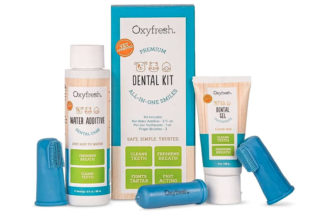
We DO NOT recommend using human toothpaste to clean your dog or cat’s teeth, as these can contain ingredients that can be harmful to dogs or cats if used over an extended period and in some formulations contain ingredients which can be toxic to pets.
It’s important that you remain committed to a daily process of brushing in order to maintain the benefits of a regular dental regime, and it’s important to quickly get your pet used to the somewhat unnatural process of having their teeth brushed.
Here are some tips for gradual introduction to tooth brushing for your pet:
- Start by gently lifting up your dog or cat’s top and bottom lip one side at a time and lightly rubbing their teeth with your finger once a day. Once they become used to this, you should begin use of the finger or tooth brush.
- Once your pet is used to you handling their mouth and rubbing their gums, use the finger brush (WITHOUT) toothpaste to rub the gums. Brush with gentle circular motions.
- Finally introduce a small blob of toothpaste to your pet onto their gums before applying this onto the fingerbrush. This will get them used to the taste of the toothpaste. Then apply the toothpaste to the finger brush and start gently brushing each row of teeth, top and bottom left and right using circular motions. Concentrate on cleaning the outside (cheek-facing) surfaces, as most pets will not allow you to brush the inside (tongue facing) surface of the teeth. Be sure to clean the back upper molars and canines, as these teeth tend to quickly build up tartar.
Be sure to reward them after their toothbrushing with play, petting or a favourite activity, to positively reinforce the brushing process
We recommend starting your pet out as young as possible while they are still puppies or kittens, as they will be far more receptive to brushing if you begin at an early age.
Use Specially Formulated Dental Dry Food
A number of dog and cat food manufacturers now make several varieties of dry food formula which has been specially designed to abrasively prevent the build-up of plaque or tartar on your pet’s teeth and gums.
At Clyde Veterinary Hospital, we strongly recommend Hills Prescription Diet t/d Dental Care for Dogs and Cats –
This diet features a specially formulated, species-specific kibble shape and size, with “fibre matrix technology” for maximum plaque reduction. Essentially the kibble biscuits clean the teeth just by the pet chomping them up and eating them!
Hills t/d comes in a formulation for cats as well as various sizes for dogs
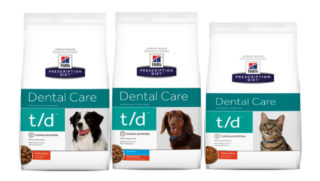
Use Dedicated Dental Chews
Similarly, several manufacturers make dedicated dental chew treats for dogs, which are a great-tasting way to supplement a daily brushing regime, and provide a little reward for putting up with the hassle of brushing.
Add a Specialised Dental Formula to Their Drinking Water
Oxyfresh have also come up with this extremely clever way of destroying bacteria and removing plaque – a dental additive solution you can mix in with their regular water – it’s completely colourless and odourless so they’ll never even know the good they are doing themselves every time they go to the water bowl – and it’s effective for both dogs and cats, or indeed any animal species.
We don’t recommend relying primarily on this as a preventative measure, but it can certainly help improve the effectiveness of a more hands-on dental care regime.

Give Dogs a Raw Bone
Although this is one preventative measure your dog will truly relish, we recommend exercising caution with this. Always supervise your pet when they are chewing a bone.
Importantly NEVER give your dog a cooked bone, as they are liable to splinter and can seriously injure your pet.
Always give your dog a human-grade meat bone (some preservatives used in inferior meats contain substances that can harm your dog), with enough meat still on to retain a degree of softness, and make sure the bone is large enough that they won’t attempt to swallow it.
Chewing on the bone’s rubbery surface can help remove plaque and tartar build-up and strengthen your dog’s gums, providing improved resistance to dental decay.
We recommend a maximum of 1-2 bones per week, and remember to try to leave a minimum 3 day gap between bone treats.
See Your Vet Regularly
This one may seem obvious, but it’s important that your pet has regular dental check-ups from an early age – you don’t want them having to live with a lifetime of tooth or other dental issues, which can lead to a loss of appetite, and restrict their enjoyment of life.
Only a professional dental check can properly diagnose and treat the often deeply hidden teeth or gum issues that can lurk deep within your dog or cat’s mouth.
Animals will also benefit from dental scaling, and your vet can advise if this would be appropriate and beneficial for your pet. Depending on the level of build-up, some dogs may need a yearly scale and polish.

Ultrasonic scalers are handheld devices which use ultrasonic vibrations to remove hard, calcified deposits from your pet’s teeth. They also create shockwaves that disrupt bacterial growth, while also washing and flushing pockets between teeth and any exposed root surfaces with water.
The procedure is usually followed by a professional tooth polish, which smooths the surface of the tooth to minimise bacteria and plaque build-up.
We do strongly caution against any lay dental practitioners who claim to perform dental scaling free of anaesthesia. For starters, the procedure can be painful and distressing for your pet, but just as importantly – it’s been shown to be ineffective as a preventative measure – in most cases, your pet is simply not going to allow anyone to insert anything deep enough into their mouths to provide for a complete and effective clean.
A Team You Can Trust at Clyde Vet
We have a team of trusted veterinarians who are leaders in pet care.
We value preventative care to keep your pet healthy and endeavour to identify any concerns before they become a bigger issue.
Book an Appointment Today
Our pets are an integral part of the family and we want to keep them safe and healthy at all times. If you have a pet you need to be aware that something as simple as feeding them the wrong food could lead to serious problems.
Familiarising yourself with common pet poisons in your animal is advisable to prevent potential toxicities. If poisoning should occur, it is also beneficial to recognise that the substance is toxic in order that prompt veterinary treatment can be sought.
If you suspect that your pet has ingested something dangerous, it is essential you visit a vet straight away. Better to be safe than sorry when it comes to your beloved pet.
Understanding toxic foods for pets
Certain human foods can cause severe health problems if ingested by a pet. In some extreme circumstances, the wrong food can be life-threatening. Certain foods can be more toxic to one species than another, so it’s important to familiarise yourself with what is safe.
Common Toxins in Cats:
There are several foods toxic to cats that can cause a range of health problems, some even life-threatening if consumed.
Onions, garlic, chives, and leeks
Onions are part of the Amaryllidaceae family. This genus Allium also includes garlic, chives, and leeks.
Allium species contain sulfoxides (sulfur-containing compounds), which are readily absorbed by the gastrointestinal tract and when absorbed into the bloodstream disrupt red blood cell membranes, resulting in red blood cell rupture which can result in anemia. As little as 5g/kg (or 20g in the average-sized 4kg cat) is enough to cause toxicity.
Breakdown products from red blood cell rupture may also result in kidney damage or failure.
Cats remain more sensitive to this form of poisoning than dogs (although this remains a toxic risk in dogs).
Signs to look for: Weakness, lethargy, pale gums, collapsing, vomiting.

Grapes, currents, raisins and sultanas
While the exact mechanism of toxicity and amount required to produce this remains unknown this food group is known to cause kidney damage and, in some cases, can result in kidney failure.
Signs to look for: lethargy, vomiting, diarrhoea inappetence, seizures.

Feeding exclusively fish, particularly if cooked or smoked (eg. salmon, tuna)
Feeding a diet comprised solely of fish is not advised in carnivores as this can result in Thiamine (Vitamin B1) deficiency. Thiamine is essential to carbohydrate, amino acid, and fatty acid synthesis and metabolism. Thiamine can be destroyed by heat, sulphur preservatives, and in diets high in thiaminase (an enzyme that breaks down Thiamine) such as raw fish. Thiamine deficiency results in progressive neurological signs with the brain being particularly vulnerable as it requires Thiamine for many critical cellular processes.
Signs to look for: Early onset vomiting and inappetence followed by possible seizuring, impaired vision, weak or wobbliness on legs, head tilt.
Dairy Products
Many dogs and cats are lactose intolerant, which means that dairy products consumed can cause gastrointestinal upset. Milk is only required in the nursing stages of puppies and kittens under 6 weeks of age. Therefore, if milk is desired as a dietary addition in an adult animal a pet milk is advised (eg. Whiskas Milk Plus Lactose Free milk for Kittens & adult cats).
Dog food
While dog food might not be toxic, it can lead to nutritional deficiencies and imbalances if consumed by cats. Generally dog food contains insufficient levels of the following nutrients required in cats:
Protein: Cats are strict carnivores requiring a higher protein diet than dogs (which are omnivores eating both meat and plant-based material). Most commercial dog foods are too low in protein to meet a cat’s protein requirement. Likewise feeding a cat a “vegetarian” or “vegan” diet is dangerous and completely inappropriate for their metabolic needs and will result in severe illness and death if continued to be fed.
Signs to look for: inappetence, weakness, lethargy, seizures, coma
Remember a cat does not have a choice in what it eats and must consume meat! Pet owners’ beliefs should not be forced on our pets at the cost of their health and well-being.
Taurine: Cats, like people, cannot make their own taurine naturally in their bodies. Cats must therefore obtain taurine from their diet. Most dog foods do not have a high enough taurine content for cats. Signs of taurine deficiency include digestive upset, loss of vision, and heart problems.
Niacin: Cats are also unable to make their own niacin vitamin within their body. Animal tissue is high in niacin, so a high-protein diet is also required in this respect.
Vitamin A: Again, cats cannot produce their own Vitamin A and must obtain it from their diet. Dog food is too low in this vitamin for cats. Signs of Vitamin A deficiency include weak muscles, dull hair coat and night blindness.
Arachidonic acid: This fatty acid is unable to be produced naturally in cats whereas dogs create arachidonic acid themselves. Dog food, therefore, contains lower amounts than cat food. Signs of deficiency can include liver and kidney disease and various skin diseases.
Acetaminophen (Paracetamol)
If you feel your cat is in pain it is often best to consult a veterinarian before administering home medications.
Acetaminophen (Paracetamol) is highly toxic to cats due to their inability to metabolise this drug due to their body lacking the required enzymes. In order for cats to metabolise Acetaminophen they must use another metabolism pathway which results in toxic metabolites (breakdown products) being produced.
Toxicity is characterised by two processes:
- The inability of red blood cells to carry oxygen around the body results in low oxygen and collapse with blue/dark gums and struggling to breathe. This may also result in kidney damage
- Liver toxicity with liver tissue damage and failure
In cats, toxicity can occur with as little as 40mg of Paracetamol ingested in an average 4kg cat! Compare this to dogs where toxicity can occur in the same size 4kg dog but with a minimum toxic ingestion of 400mg. This illustrates the cat’s sensitivity to this toxin and marked inability to process it.
Signs to look for: Dark brown/muddy gum colour or blue gum colour, increased heart rate and respiratory rate, weakness, collapsing, depression, weakness, vomiting, hypothermia, yellow gums or skin (icterus), facial or paw oedema (fluid swelling)
Common Toxins in Dogs:
As dogs love wandering around the home trying to find food, it’s important to be mindful of what food is in reach. There are many toxic foods for dogs that you may have around your home and yard without even realising.
Macadamia nuts
The process involved in producing toxicity from macadamia nuts remains unknown however even consuming small amounts of these can lead to very serious illness. It should also be kept in mind that macadamia nuts can be coated in other products that are toxic to pets such as chocolate, xylitol sweetener, and grape products.
Signs to look for: weakness, staggering, vomiting, tremors, hyperthermia.

Chocolate
While chocolate is a toxic food for dogs and cats, dogs are more likely to be affected as cats are usually too discriminating to eat chocolate in large quantities.
The severity of chocolate toxicity depends on the type of chocolate ingested, the amount and the size of the pet.
Chocolate contains methylxanthines; namely theobromine and caffeine
Darker and more bitter chocolate (eg. higher percentage cocoa and cooking chocolate) contains more theobromine and caffeine and hence tends to be more toxic than milk and white chocolate but again this will depend on the quantity consumed.
It is also worth remembering that some chocolate products contain other toxins such as coffee beans, macadamia nuts, raisins and xylitol.
Signs to look for: hyperactivity, increased heart and respiratory rate, vomiting, diarrhoea, increased thirst, hyperthermia, tremors, and seizures.
Xylitol
Xylitol is a sweetener used as a sugar substitute in many pharmaceuticals, oral care products and as a food additive. It is found naturally in fruits such as berries and plums as well as corn, oats, mushrooms, lettuce and many trees. Commercially used Xylitol is extracted from corn fibre or birch trees and has gained popularity as a sugar substitute due to its low glycaemic index and dental plaque fighting properties.
Products containing xylitol include:
- Oral care products (eg. Mouthwash, toothpaste, sugar-free gum, breath mints)
- Foodstuffs (eg. Candy, baked goods, peanut butter, pudding snacks)
- Supplements and over-the-counter medications (eg. cough syrup, chewable or gummy vitamins, nasal sprays, skin care products, laxatives, digestive aids, allergy medications, mouth lozenges, sleep supplements)
- Pharmaceutical medications especially those formulated as quick-dissolve tablets or liquids.
Xylitol is extremely toxic to dogs. The Xylitol is absorbed into the bloodstream which causes a rapid release of insulin from the pancreas which results in a marked drop in blood sugar (hypoglycaemia) which can be life-threatening. Xylitol is also known to cause seizures as well as liver failure however this process is poorly understood.
Signs to look for: vomiting, lethargy, weakness, wobbliness, tremors, seizures, coma.
Are plants dangerous to pets?
Certain plants contain toxins that can cause a range of health problems if ingested ranging from mild to severe.
Familiarise yourself with what houseplants are toxic to pets so you know what plants to keep away from your home. You should also make sure there are no toxic plants growing in your garden that could be a problem for your pets.
Lilies
Lilies are one of the most common toxic plants for cats. Ingestion of any part of this plant (flower, stamen, leaves or stems) can cause kidney failure.
All members of the genera Lilium and Hemerocallis should be considered nephrotoxic to cats and potentially dogs. This includes the Easter lily (Lilium longiflorum), tiger lily (Lilium species) and daylily (Hemerocallis species), among many others.



Signs to look for: Initial depression, vomiting, inappetence. If allowed to progress lily toxicity can result in kidney damage and failure.
Sago palm
Part of the Cycad/Cycas, Microzamia or Zamia genus these palms are also known as Coontie palms, Cardboard palms, Japanese cycad, Cycads, or Zymias, sago palms and are readily available for purchase in stores ranging from small nurseries to the garden sections of large home improvement stores. All parts of the sago palm plant are toxic.
Signs to look for: Gastrointestinal irritation with depression, drooling, vomiting and diarrhoea. Neurological signs including weakness, wobbliness, tremors, and seizures. If left untreated advanced signs may include liver damage with yellow skin or eyes (icterus), increased thirst and urination and dark urine. With liver disease decreased blood clotting may also occur resulting in bleeding both internally and externally.

Aloe vera
While aloe vera can be beneficial to humans, it can cause vomiting, diarrhoea, and digestive upset in dogs and cats if ingested.

Azalea and Rhododendron
Azaleas and Rhododendrons are classified as part of the same family with all parts of the plant including the flower, leaves and shrub being toxic.
These plants contain a toxin called grayanotoxin, which disrupts the electrical pathway in muscle tissue including heart muscle.
Signs to look for: Gastrointestinal signs: inappetence, drooling, vomiting diarrhoea, abdominal pain. Cardiovascular signs: abnormal heart rate, low blood pressure, Neurology signs: depression, muscle tremours, blindness, seizures, coma.

It is important to note that these lists are by no means exhaustive and there may be other toxins that may cause potential health concerns in your pet.
What to do if your pet is unwell?
Contact your veterinarian immediately for guidance on the best course of action. Observe any symptoms and follow your vet’s recommendations for treatment, which may include medication, rest, or changes to their diet or environment. Prompt intervention can be crucial for a successful recovery, so don’t hesitate to seek help if you have concerns about your pet’s health.
A vet you can trust at Clyde Veterinary Hospital
We have a team of trusted veterinarians who are leaders in pet care.
We value preventative care to keep your pet healthy and endeavour to identify any concerns before they become a bigger issue.
If you have any questions or would like to book an appointment please give us a call at (03) 9069 4088 or email us at info@clydevet.com.au
Just like every other member of the family, your pet’s mental health is important for their long-term wellbeing. If your pet is anxious, bored or without much stimulation, over time it can seriously affect their physical and mental health and over time their relationship with their owners.Luckily, there are some simple changes you can make to your cat or dog’s everyday experience that can help them live a happier and healthier life. Here are some of the expert pet enrichment suggestions from the team at Clyde Vet Hospital – and some of the signs you need to watch out for in your pet.
How to tell if your pet is unhappy
Nobody knows your pet like you do, which means you’re the perfect person to spot whether or not they need a little help. Even small changes in behaviour can point to a bored or anxious pet that needs more stimulation in their life.
Tips to help your pet live a happier life
Clyde Vet Hospital has a number of tips and tricks to help your furry friends get back on track. These pet enrichment ideas are a great place to start when trying to overcome any pet anxiety in your home.
Signs that your dog may need enrichment
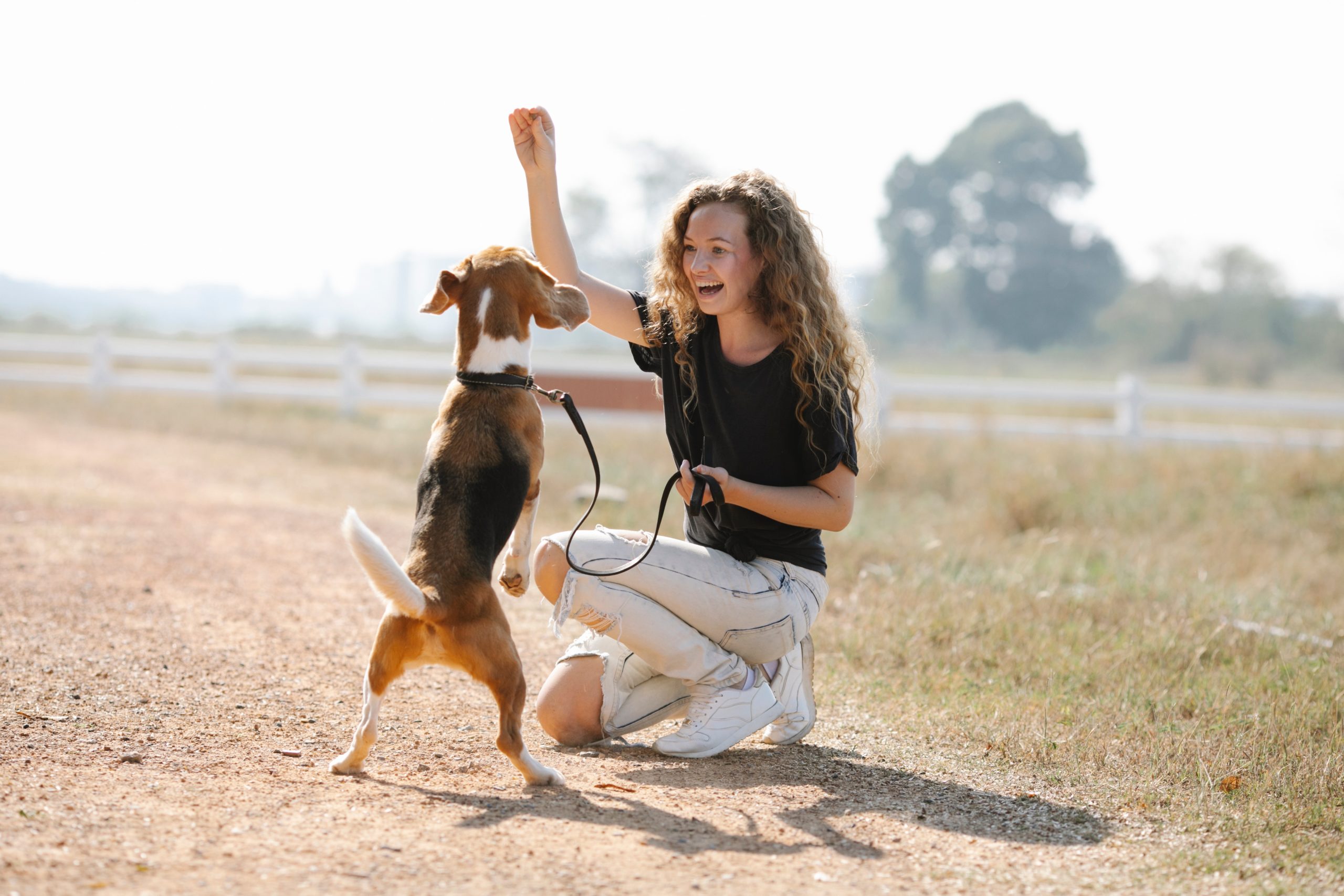
Dogs that are bored or not stimulated enough need to find an outlet to relieve their emotional stresses and pent-up energy. This is typically the case in younger dogs that have high energy levels. Signs to look for can include:
- Excessive barking, sometimes for no specific reason: this may be be due to relieving boredom or your pet may be looking for interaction with you via a response to the barking.
- Chewing or excessive licking of objects (eg. shoes, couches, kids toys, small household items / decorations): the reason for this behaviour is similiar to why dogs bark however there is a danger that accidental ingestion of these objects can occur. Ingestion of foreign objects may cause abdominal pain and in some cases result in the object becoming stuck in the gastrointestinal tract which may require potential surgical intervention.
- Excessive digging: digging is a natural evolutionary pass time for dogs as in the wild they will bury prey / food and come back for it later. However when this becomes excessive and results in destruction to lawns, garden beds, vegetable patches it can become problematic.
- Uncharacteristic aggression with family members or strangers: This may be due to overstimlation and no channeling of pent up energy or frustrations.
- Increased pacing: again this is often due to boredom and pent up energy but please be mindful that may not be the only reason for this behaviour. Dogs in pain or even with neurological disease may also present with this problem.
- Increased quietness or depression: older dogs that are more settled in their routine may show boredom as increased quietness and lethargy
How to enrich your dog’s life
Most dogs are incredibly active animals, especially high activity level and working dog breeds. Working dog breeds are also highly intelligent and thus can get bored and frustrated easily if their mental needs are not being met.
As such dogs require regular exercise. Being cooped up in a small backyard all the time can be boring and can result in behavioral problems developing; like those mentioned above. Behavioural problems can be difficult to break if they become a long term habit.
Dogs are pack animals and as such they require other people and animals to interact with.
Tips for dog enrichment:
- Daily walks: Dogs should be walked at least once a day (twice a day for active, high energy breeds). Often going to the park for a walk and a play at ball in off lead parks can be stimulating. Also try new and unique locations (eg. beach) and places to stop along the way for a break and a sit down may also prove rewarding.
- Puzzles, toys: puzzle toys that require problem solving such as mazes where a treat can be hidden (eg. KongⓇ toys) are a great way to keep dogs occupied and as a bous give a reward for their effort if they get the treat out.
- Frozen treats: Making your own frozen “pupsicle” treats is a great way to reward your pet as well as keeping them stimulated. As always please consult your veterinarian if you are concerned about potential toxicity in any of the ingredients you are using.
- Arrange a play-date with another dog: – join a local dog group if you don’t already know any other dogs nearby!
- Owner / dog playtime: sometimes it is you the owner and your time and interaction that will boost your pets mood. So take that extra time every day, even if it is just an extra 5 minutes to have a play and run around with your dog.
Signs that your cat may need enrichment
Whether they’re indoor or outdoor, your feline friend will still exhibit the same basic behaviours if they’re generally unhappy. Signs to look for can include:
- Excessive vocalisations: cats, especially young cats will vocalise in order to communicate. This can become excessive if they are demanding something from you as an owner (eg. food, attention)
- Clawing / scratching furniture: Cats have evolved to scratch their claws on trees to shed the excess nail layer and keep them sharp for hunting. This also serves as a territorial scent mark for other cats in the area. Unfortunately cats do not understand that your chair / couch leg is not a tree!
- Excessive grooming: this can be due to other problems such as infections and parasite burden and pain but in the context of behavioural anxieties it can be due stresses that are misdirected as the cat overgrooming
- Extreme clinginess to you / other family members: There is a misconception that cats are not as affectionate as dogs but this has recently been disproven that cats are indeed as invested in their owners if not moreso than dogs. As such cats if they are sick or stressed will seek comfort and reassurance from their owner.
- Excessive sleeping: this can be due to illness but may well also be a clue that they are not as interested in or stimulated by their surroundings.
- Frequent hiding: Again this can be due to illness but also due to stress
Tips for cat enrichment:
Cats don’t require the same level of exercise as dogs in order to feel comfortable and happy, but they do require lots of mental stimulation and play (especially if they’re an indoor cat). This can include:
- Toys: these can include soft toys (with or without pull string motors for movement), feather wands and laser pointers. Toys that encourage chasing and hunting behaviour are best as they keep the cat stimulated as well as potentially wearing out high activity level cats! Keep in mind that changing over new toys every couple of months is important as cats can get tired of the same toy long term. A good trick is to put a small number of toys in storage and rotate them every couple of months.
- Scratching posts: A few strategically situated scratching posts around the house will still enable the cat to mark their territory, keep their claws healthy and also save your furniture!
- Hiding places and high perches: Cats are evolutionary both predator and prey and as such they like to be high up above everything where they can survey and assess from a safe distance as well as having dark places to hide if they feel threated. Regularly updating their environment with new objects (eg. boxes, wall shelf / perch, cat towers and stations) are a great way to keep them stimulated and comfortable.
- Cat grass: Cats eat grass as it aids in digestion and general health. Having a cat grass plantar in the house that the cat can graze on is a great way to keep them happy & healthy. Cat grass is available as seeds and the fully grown grass from most nurseries.
- Owner / cat playtime: sometimes it is you the owner and your time and interaction that will boost your pets mood. So take that extra time every day, even if it is just an extra 5 minutes to have a play and hide and seek around with your cat.
- Giving your cat multiple different ways to express themselves and their instincts is the key to making sure they’re sufficiently stimulated.

Your local pet experts
If you’ve noticed any challenging or concerning behaviour in your pet and want to make sure that they’re okay physically or mentally, then don’t hesitate to book a visit to the expert veterinarians at Clyde Vet Hospital. We can help you figure out what’s holding your pet back and offer a range of different solutions for a happier, healthier and longer life with you.
Get in touch with our friendly team at (03) 9052 3200, or make an online booking at any time on our website.
Responsible pet owners want the best for their beloved cat or dog, including their skin care. When you notice excessive itching, scratching or discomfort from your pet, it’s time to take action. If a pet looks like they have skin irritation, it could be a sign that something is wrong and shouldn’t be ignored. These behaviours can be a response to a variety of things such as pet allergies, parasitic infestation, a bacterial or fungal infection, dry skin, or boredom.
When a pet is constantly scratching or chewing at their skin, they run the risk of prolonging and worsening any potential skin problems. Knowing the telltale signs of various pet skin conditions will help you find appropriate treatment sooner so you can put an end to your pet’s skin irritation and keep any issues at bay.
Signs of skin irritation in pets
If your pet has skin irritation, you may notice a red wet patch on their skin or coat, or you will catch them in the act of licking, scratching or chewing that area of their skin. You will also notice a few changes to their coat that will signify something is wrong
Some of the more common signs to look out for are:
- Chewing, licking, biting or scratch their own skin
- Hair loss or bald patches
- Rashes
- Dry flaky skin
- A dull coat
- A distinct smell/odour that resembles wet socks
Cause of pet skin conditions
Helping your pet’s skin conditions can feel like a never ending battle. The rash on your pet’s skin could have been caused by them incessantly scratching and tampering with their skin, but there’s most likely an underlying cause to explain why your pet is feeling this level of discomfort.
Pet allergies
Noticing sudden strange patches on your pet’s skin can often raise a few questions such as ‘is my dog injured?’, ‘does my dog have allergies?’, ‘has my cat been attacked?’. The truth is, your furry friend can be susceptible to pet allergies regardless of their breed or age. Allergies can often be triggered by food or environmental triggers such as pollen, dust, grass, mould and other allergens. Testing can be done to determine the trigger so you can try to minimise your pet’s exposure to some of these allergens.
Skin allergies and dermatitis
Dermatitis is the name used to describe skin allergies. Unfortunately, skin allergies are often a long term, chronic condition that will require ongoing treatment for your cat or dog.
Other skin allergies can be caused by contact dermatitis which is often the result of your pet coming into contact with chemicals or plants that cause a reaction.
Parasites
Parasites that commonly affect pets include ticks, fleas, fungal infection, mange, lice, and ear mites. Some parasites cannot be seen by the naked eye until there is a large infestation. It is important you monitor any changes in your pet’s behaviour, and get them tested and treated for parasites if you notice any signs. Leaving parasites untreated can result in further discomfort, skin irritation, and more serious health issues.
Boredom and anxiety
Excessive chewing, scratching or licking isn’t always the result of a physical reaction. Sometimes it can be a sign that your pet is experiencing psychological discomfort and is trying to self-soothe. Identifying what is causing your pet distress, along with finding a way to keep your pet calm, will help to prevent these compulsions.
Pet skin care tips
Whether you’re trying to better manage cat allergies, dry skin, parasites, anxious pets, dog allergies, or recurring skin conditions for your pet, there are a few things you can do to help ensure your pet’s skin stays healthy.
Diet
A proper diet is absolutely essential for your pet to live a happy and healthy life. We’ve already established that skin concerns can be attributed to food allergies, but they can also be the result of an improper diet. Feeding your dog or cat food that is poor quality or lacking in certain nutrients can affect the condition of their coat and underlying skin.
Medicated shampoo
Unlike regular shampoo, medicated shampoo can help provide relief quickly and effectively for pets with skin conditions. Medicated shampoos are specially formulated with active ingredients such as antibacterial agents to treat common pet skin conditions.
Monitor faeces
Faecal testing is the best way for your vet to check your pet for intestinal parasites.
Testing your pet’s faeces every six months can ensure that your pet isn’t suffering from worms. Regular testing can help catch parasites early, making them easier to treat.
Keep a diary
Keeping a record of your pet’s symptoms, behaviour, medicine, and meals will help you and your vet to gain a better understanding of your pet’s health.
Diagnosis
As soon as you notice any signs of skin discomfort in your cat or dog, take them to the vet for a check up. Getting your pet checked for any allergies or parasites can help prevent symptoms from spreading, and allow for faster treatment.
Prior to trying any medicated creams, or if you are unsure what treatment is best for your pet, the friendly team at Clyde Veterinary Hospital can offer the best advice during a consultation. If you have noticed any changes in your pet’s behaviour, or think your pet might be suffering from parasites or an allergic reaction, please contact us on (03) 9052 3200 or make a booking online today.
Giving your best friend the best chance at living a longer, healthier life is the goal of every loving pet owner. Doing what’s best for your pet goes beyond keeping it well fed and hydrated, and extends to ensuring that your fur baby receives regular pet dental care at home and at the vet.
Proper dental care for pets helps to prevent and protect animals from a number of health issues that arise when their teeth aren’t properly looked after. Additionally, when an owner takes the time to maintain their pet’s dental health, they help to improve their pet’s well-being and minimise the likelihood of harmful bacteria from the gums passing onto the major organs in your pet’s body.
National pet dental health month is the perfect reminder of why it’s important to look after your pet’s teeth and gums. By recognising the signs of dental disease and taking steps to prevent it, you can help improve the quality of life for your pet for the years to come.
Recognising dental disease in pets
Poor pet dental health in your dog, cat or bunny often first presents itself in the teeth, gums and surrounding areas of your pet’s mouth.
The slow buildup of plaque can cause issues over time, eventually spreading bacteria throughout the body. If not removed correctly, the plaque can also harden and become tartar, which will need to be removed by a veterinary clinic offering pet dental health services. Fortunately, tartar above the gums can be removed and cleaned by a professional. By getting to it early, you minimise the likelihood of tartar moving below the gum line and causing your pet serious pain and discomfort as a result of inflammation and infection.
While plaque and tartar can often be seen by looking in your pet’s mouth, sometimes it can be hard to notice when you’re unsure what to look out for. As a general rule, don’t assume that your pet’s teeth are healthy without getting a pet dental health check and maintaining pet dental care.
If your pet has a buildup of plaque and/or tartar that has caused its’ dental health to deteriorate, you’ll likely recognise one or more of the following signs:
- Bad breath
- Irregular/abnormal eating or drinking
- Broken/loose teeth
- Excessive drooling
- Bleeding from the mouth
Once you notice any of these signs, it’s a good idea to go to the vet to get your furry friend checked out.
Benefits of maintaining pet dental health
Ensuring your pet receives proper dental care both at home and at the vet is vital. By practising proper dental care, pets are more likely to experience improved overall health that will help them in the years to come. Having a good level of dental care for dogs, cats, bunnies and more helps them in five key areas.
The most important reason to maintain a thorough level of dental care for pets is to help prevent the likelihood of organ damage caused by dental diseases or infections. You also minimise the potential for the gum disease to get worse. Any bacteria that makes its way into the bloodstream has the chance to spread to the heart, liver and kidneys of your pet, potentially making them extremely sick.
Additionally, proper dental care for cats and other animals can help prevent them from losing teeth, feeling pain in their mouth region or having bad breath. This helps them live freer and helps to ensure they can eat, drink and behave as normal.
Quality and affordable pet dental care
Pet dental health awareness month is the perfect time to book your best friend into your local veterinary clinic for a checkup.
At Clyde Veterinary Hospital, we provide dental health services for dogs, cats, rabbits, rodents and ferrets. We pride ourselves on treating animals in our state-of-the-art clinic and using gold standard service and dental equipment.
With dedicated dog and cat treatment areas, you can trust that your beloved pet will receive the highest quality, tailored care. We use the best pet dental care products and perform rigorous pre-anesthetic testing to help ensure your pet receives the best treatment possible.
Book an Appointment Today
One upside of the COVID pandemic has been the surge in people adopting new cats into their home for the first time, with some reports indicating new pet registrations are up by almost 25%, and shelters are struggling to keep up with demand, meaning animals are spending far less time in shelters and the outcomes are far better for animal welfare.
But the surge in new cat and dog adoptions means that there are more brand new pet parents than ever before. And if you’ve never owned a pet before, the curve for learning about the unique needs of your new pet and how to care for them is steep.
That’s why I thought our first ever “CAT MONTH” at Clyde Vet, lasting all this May 2021 was the perfect time for another post in our occasional series looking at bringing home new pets – and this month, we’ll examine a checklist for new cat parents to follow before bringing home a new cat or kitten.
And a quick reminder to new cat parents we also routinely offer free kitten (and puppy) health checks for kittens up to 10 weeks of age. Follow the link to learn more.
Things To Do Before Bringing Your New Cat Home
So, diving in to our topic today, one of the first and most important things that new cat owners should be aware of is that Cats are highly territorial animals, and extremely sensitive to changes in their environment. So introducing your new cat or kitten to their new home for the first time can be a tense and frightening experience for them, while you are no doubt feeling the opposite.
Failing to address this disconnect between owner and feline perceptions of the new situation is one of the most common mistakes that new cat parents make, as they wind up only enhancing their cat’s stress levels and making the transition period longer and bonding with their cat less quickly.
It’s important that new owners are sending signals that their cat can recognise that you are not a threat to them, that you will provide for them, and that they are going to be perfectly safe in their new home in order to make your new cat’s transition to their new home as smooth as possible.
Hopefully this article helps new cat adopters avoid the most common pitfalls, and we’ll have kitty parading round your home as if it were her own in no time.
Indoor or Outdoor
The biggest decision you will need to make in advance of bringing your newly adopted cat home is whether the cat will be restricted to an indoors-only environment or not. There are of course many valid reasons behind either choice, and it’s well beyond the scope of this article to help you make that decision.
Whatever you decide, we recommend that you plan to keep your cat exclusively indoors for at least 3-4 weeks, until they have developed a sense of your home being their “territory” before allowing your cat outdoors to ensure that they do in fact return “home” whenever they venture outdoors.
If your new cat is a kitten, we recommend keeping them indoors until they are at least 6 months of age, by which time they should be large enough to jump and climb out of the way of any threats effectively, and know their own abilities well enough not to get stuck in any tricky situations.
The Importance of Microchipping
No matter whether you decide your cat will be indoors-only or allowed outside, having them microchipped and registered with your local council is a legal requirement for all cat owners in Victoria. If you acquired your new cat or kitten from a shelter, chances are the animal will come to you pre-chipped, and you just need to arrange the necessary paperwork at the time of adoption.
But if your animal is not microchipped, this should be an urgent priority for you – we offer a quick and easy microchipping service here at Clyde Veterinary Hospital – Book Online or ph. 9052 3200 for more information.
CLICK HERE for links to City of Casey Pet Registration
CLICK HERE to locate or update your cat’s existing microchip registration
Tuning in to ‘Cat TV’
It’s important to remember that an indoor-only cat’s environment is entirely comprised of your home, and so if you make the choice that your new cat will be indoor-only we recommend paying extra close attention to preparing your home environment ensure they are not bored and are getting all the stimulation they require from their environs.
Your cat will likely relish the opportunity to have a “window on the word” or “cat tv”, as many owners call it – consider setting up a basket or blanket near a window (one that attracts a decent amount of direct sunlight will be most gratefully appreciated, but remember direct sunlight is a cancer risk for red nosed cats or those of lighter fur colours).
Try to think about what you can do to make the “TV” as entertaining as possible – windows that give them a peek into what’s happening on the street are ideal, and many owners will set up bird feeders in strategic locations, as the sight of potential prey is extremely stimulating for cats.
Another form of “cat TV” could be a fish tank, but bear in mind all potential safety issues for both your cat and your fish – make sure the tank is fully enclosed and ideally that your cat doesn’t have the opportunity to jump up on the tank.
If possible, we recommend investing in a high quality cat tree for your new family member. Climbing is a natural instinct, and it’s part of the reason they have evolved those highly effective claws. Having the chance to climb up to or beyond your level lets them exercise those instincts, and cats seem to love observing the world from up on high, so a high perch on their cat tree will often be a favored resting place.
Try again to consider positioning the tree relative to any external windows so they can have a special extra window on the world from up there.
New Cat-Proofing Your Home
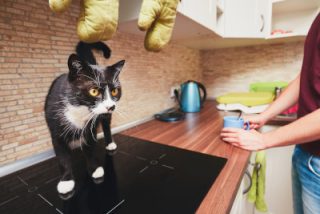
In instances where your cat jumps up on such a surface, clap your hands or make some loud, sudden noise and if possible make a quick arm raising gesture directly in the direction of the cat.
However, try and avoid shouting or yelling at your cat directly, as they will misinterpret this not as rule enforcement, but as unprovoked aggression from their owner. All this does is increase your cat’s sense of confusion, particularly if it’s still early days in their new home getting to know who you are and to form a bond with you.
There are probably a lot more potential risks to their cats lurking around new owners’ homes than many realise. But you can follow this simple checklist which runs through some of the most common ones to make sure your home environment is safe as possible for your new cat:
- Remove or place in a secure place any breakable items or items that might harm your cat if accidentally knocked over.
- Store any wand toys securely in a cupboard or otherwise out of reach, as the string is a strangulation risk.
- Keep garbage cans out of reach and secure.
- Many plants and flowers are toxic to cats, and lilies are one particularly toxic yet common indoor plant to watch for. Any lillies should be removed from your property completely before bringing your new cat home. RSPCA Victoria has produced this list of 42 of the most common problem plants to watch for.
- Keep grocery and other plastic bags safely stored and out of reach, as these are a suffocation hazard.
- Keep toxic household products, including medications and pharmaceuticals, cleaning products, anti-freeze and paint out of reach.
- Venetian blinds and curtain cords are a strangulation risk. Shorten these strings and place out of reach.
- Look for holes or registers that leave ductwork accessible and cover them up. A kitten can easily slither into one of these.
- Block off small spaces so your cat can’t get trapped in them. Cats like to hide in small dark spaces when they’re scared.
Indoor-only cats will also need to have their environment secured to prevent escape. The following checklist should ensure you have everything covered
- Secure window screens that can be easily removed and repair or replace torn screens.
- Consider installing a screen door on exterior doors to prevent your cat making a dash for the wider world.
- Lock screen doors so your cat cannot push them open. Retractable screen doors are not secure.
- If you have a balcony, deck or “cat run” to allow your cat enclosed outdoor time, make sure it is COMPLETELY secure, as your cat will be naturally inclined to want to explore beyond.
- Some owners allow their cats outdoor time on a lead or harness, and this should ONLY be done under your total supervision, as their risk of injury is high if they become entangled for any reason.
- If your cat appears to be a “door darter”, try keeping a squirt bottle with water by each door. Each time the cat attempts to dart, give it a small squirt of water.
- Never leave your door open “just for a minute” while you take out the garbage, bring in the washing, etc. Many cats are devastatingly lost to their owners in these “just one minutes”.
You should make sure you’ve done all your shopping in advance, and have your home prepared for kitty well in advance of their arrival. The following shopping checklist covers all the essential items.
Choice of Cat Litter and Litter Tray
The choice of cat litter and litter tray can be one of the most vexing decisions new cat owners have to make, in that you can’t take your cat to the supermarket and have them pick their favourite from the shelf, so you’re going to have to make this selection for them.
If your new cat is an adult cat, try to find out what litter and/or litter tray setup your cat was using previously, and if possible replicate that for them in their new home as closely as possible.
Cats can be extremely individual in their toilet habits. Owners tend to find some will be extremely picky about where they relieve themselves, preferring only the cleanest and most pristine litter environments, while others will tolerate the presence of some buildup of waste material.
Some cats are completely nonplussed at the choice of material for their litter, while others will only tolerate one specific product they are used to. Some cats will also resist certain types of litter tray, and so we recommend “hastening slowly” to find the best combination here, and unfortunately a little trial and error may be required.
The tray itself is going to be your biggest single investment, so we recommend starting out with a standard plastic floor standing litter tray – these are available both with and without a removable protective rim.
More complex “domed” type structures can be great from an odour and litter containment perspective (not to mention being much more attractive around your home), but cats are not naturally used to relieving themselves in confined spaces, so the learning curve is going to be much steeper for your cat if they’ve not learned to use one already.
We recommend using a litter tray with a protective plastic rim to reduce the amount of material your cat may fling outside the tray as they cover up their deposits, but bear in mind that it presents an extra obstacle to your cat, and if they appear to be at all reticent in entering their tray it’s a good idea to remove the rim temporarily until they’ve become accustomed to the new tray.
If you are bringing your cat into a household with existing pets, it’s a good idea to allow your existing and newly adopted cats to each have their own litter tray, which will lessen any territorial conflicts and reduce any aversion your new cat may have to crossing another cat’s territory. Make sure your dog doesn’t have access to your cat’s litter box because, as scavengers, dogs are likely to consume the contents – not nice, but true!
Using plastic litter tray liners is also recommended – these are available alongside the kitty litter in most supermarkets and pet stores. Tray liners allow you to remove the contents of a soiled tray (for many owners, the most unpleasant of their cat parent duties) quickly and easily and with the added benefit of starting each new tray largely free of any odours from the previous one.
Litters themselves break down into three broad categories based on the material they are manufactured from, those being wood/paper, clay/clumping and crystal.
While there are a few products that blur the boundaries between these categories a little, in general wood or paper products are best for liquid absorbtion and keeping urine smells at bay, clay or clumping products tend to handle the faeces odour better.
Artificially formulated crystal products offer a good compromise between both, and are usually heavily scented for excellent all-round odour reduction, but of all the three types of litter product, this is the one that cats will most often refuse to use. Some cats appear to find the crystals a poor approximation of the organic natural environments where they instinctively seek to relieve themselves.
So, if you intend starting your newly adopted cat out on crystal litter, we recommend also purchasing a more traditional wood pellet or clumping litter to have on standby, should they simply refuse to use a crystal litter.
“Tracking” is another factor that many owners like to consider in their choice of litter. By which we mean the tendency of some litters to attach to your cats’ paws as they exit the tray, and become tracked around the home.
Again, a little trial and error with individual brands can help work out what works best with your cat and on the particular surfaces in your home, but in general cat owners tend to report the most difficulty with tracking from wood grain and paper products and less with the denser crystal ones.
So, while we recommend trying to keep changes in their toilet going habits to a minimum during the induction phase, it’s perfectly possible to change a cat’s preferences for their type of litter if you find it is causing you problems. We recommend slowly introducing some of the new litter in with old in small ratios to start with, and then steadily upping the percentage of new litter type that you use with each successive tray change until kitty has fully adapted.
Have the litter box filled according to product instructions and lined with a litter tray if you are using one, ready for the arrival of your newly adopted companion. We recommend you make showing your cat the location of the litter box in their new home the very first act you undertake as soon as you remove them from the carrier.
Cats are creatures of habit when it comes to toilet practices, many older cats will instinctively know what a litter tray is, even if they’ve never seen THAT one before, but kittens or cats that have never been socialised won’t have this association.
As with all aspects of cat training, it is important that you don’t punish any bad behaviour by yelling or shouting. However, if you see your cat in the act of squatting or actually relieving themselves in an inappropriate location should you should either make a loud sudden noise or keep a spray water bottle handy to fire off a quick squirt of water in order to the problem behaviour, then if possible take them immediately and show them their litter tray.
Reward them with a treat if possible for showing interest in, or better for actually climbing in their litter tray, better still obviously if they can be encouraged to use it.
Cat Food and Water Bowls
While this might initially seem like a simple purchase, these days there are a number of products to assist in your pet’s feeding that go far beyond the traditional functional bowl that just holds water or food. Cats are naturally drawn to running water, and maintaining your cat’s fluid levels is important, especially if you intend feeding them a mostly dry food diet, so many owners opt for a more technologial solution – there are a number of water drinking fountain products on the market today which help circulate your cat’s drinking water constantly, providing a more inviting option for your cat.
We strongly discourage the use of any of the many timed feeding products for dogs or cats (if you’re leaving them unattended for a period long enough to require feeding, you should either arrange for someone else to come and feed them for you, or have them placed in suitable care somewhere (such as Clyde Vet’s in-house cat boarding facility).
However, there are a number of products on the market which can help turn your cat’s meal time into an engaging and fun activity, and these can be great from a “boredom buster” perspective for indoor cats who are required to spend a significant amount of time at home unaccompanied.
Types of products in this category include dispenser toys such as the Kong Cat Treat Dispensing Wobbler, and “lick mats” or other puzzle games, which can actually deliver health benefits to your cat by slowing down the meal process and so help prevent overeating. Lickimat is an Australian-owned company making some brilliant cat lick mat products that look great around the home to boot.
You will also find a wide array of food-dispensing puzzle type toys on the market, which are a fun way for your cat to “hunt” for his food, and are a great way to bust boredom for indoor cats in particular. However, we recommend you do not start using a food-dispensing toy or lick mat until your cat has completely settled into their new feed routine, usually after about two to three weeks.
Cat Food & Treats
The biggest choice that cat owners will face in this department is whether they are going to feed their cat wet or dry food. There are many schools of thought about the appropriateness of either diet for cats, and it’s beyond the scope of this article to dive into that in full depth.
Suffice to say that we see plenty of cats who live out happy and healthy lives on either food source here at Clyde Vet, and we see lots of cats who present with severe dietary issues who are receiving either. So we’d suggest from a veterinary perspective the choice of food is not so important as the dietary practices you put in place around it.
This article explains in more depth the importance of maintaining healthy body weight for cats and dogs, with some tips for owners to help them do so.
Decide whether you wish to feed your cat once daily, twice daily or free choice (which means leaving dry food out at all times). Many cats who are fed free choice do not properly control their food intake and tend to be overweight, which predisposes them to health problems. For most cats, twice-daily feeding is ideal.
We recommend that you have a bowl of water ready, or their water fountain filled in advance of releasing your newly adopted companion into their welcome room, but do not provide food for the first hour.
Your newly adopted cat may not eat much or at all at first, and once the food smells stale to them may provide a further disincentive for them to start eating. For this reason also, starting out with a bowl of dry food can be beneficial. Your kitty will likely be in hiding, place the food bowl somewhere near them where they can see and smell it – but use it as a means of drawing them out into the wider room a little once their appetite does pick up.
It’s best to try to give your new cat the same food she had at the shelter or in her previous home, at least at first. Keeping some things familiar will make them feel more secure. Be sure to change her water frequently and make sure that she is drinking. If your cat hasn’t eaten for a few days, call your vet to ask for advice.
Cats who are experiencing extreme stress through their change of environment may not eat much during the first 24 to 48 hours and may experience temporary diarrhea from stress, and this should not be considered too much of a concern if you observe it.
We recommend also having a pack of eible kitty treats, such as you will find accompanying the cat food section of your local supermarket or pet store, available usually as kibble based treats, but dried fish or fish loin sections can also be a huge winner. These treats can be used for positive reinforcement training in a wide range of cat behaviours.
In general cat owners tend to find their cats may have a preference for certain types of treats, and you should try to learn this over time through trial and error of a few different treat types, but equally most cats will have some sort of appetite for most commercial kibble-based treats.
Remember, you should never scold or yell at your cat, as they do not know how to interpret this behaviour. Instead, look to disincentivise problem behaviour when you see it with quick, loud noises or squirts from a water gun, and make sure you ALWAYS reward the positive behaviour, eg using their litter tray during toilet training with a reward in the form of a treat.
It is extremely important to make sure that your cat is eating regularly (and adequate amounts) once you have brought him home. Cats eat less when they are stressed, and sometimes stop eating altogether.
If your cat has not eaten after 48 hours in their new home, try giving them a couple of kibble treats to stimulate their appetite. If this is not successful, and they are not showing signs of eating well into their third day with you, you may want to consult your veterinarian for advice.
After two days, or once he is eating regularly, slowly change them over from their previous diet to the one that you would like to feed him (if different from what he had previously). On the first and second days, feed him 25 percent of your diet and 75 percent of the shelter’s diet, mixed together. On the third and fourth days, give him 50 percent of each, and so on.
Changing your cat’s diet too rapidly can cause upset to his system – the key symptoms to watch for are decreased appetite, vomiting, and/or diarrhea. If you observe any of these during the switchover of food types it should not be a huge cause for concern, but we recommend you call your veterinarian for further advice.
Grooming Brush
Medium or long-haired cats will require some assistance with their grooming to prevent the build up of hairballs. Brushing makes for a great bonding activity with your cat, but remember that for kittens and any cats that have not been thoroughly socialised around humans, it’s not a natural activity, and having their owners suddenly thrusting a pointy object like a brush at them can be threatening and confusing until they’ve learned to associate it with pleasurable activity.
So, while it’s good to try and introduce brushing activity into your routine a soon as possible – particularly for longer haired cats, don’t try and force them into the activity. Instead, just make a couple of times a day where the cat will allow you to make contact between the brush and their coat, and you’ll find one they learn the brush is not a threat, most cats learn to enjoy the activity.
Older cats may be an exception to this rule, in that if an older cat has gone most of its life with an aversion to brushing, attempting to break that habit is going to be extremely stressful for them, and will only complicate and lengthen the induction process. Older cats can certainly form new habits, but this is best attempted once you are fully bonded with your new companion, and you’ve completely earned their trust.
Many people think fur clipping is only for dogs, but older cats, and cats with severely matted coats may benefit from having their fur clipped occasionally, as severely matted fur can affect their quality of life and their self esteem.
Another common myth is that domestic short haired cats never need grooming or brushing, but in fact all cats benefit from making brushing part of their regular veterinary care regime.
Cats’ Itch to Scratch
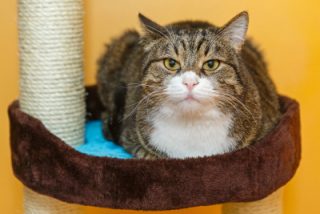
Put a new scratching post (at least one metre tall) inside the welcome room. Scratching is a natural and comforting behaviour for cats, so being able to have a bit of a scratch at something will help them relieve stress.
It’s also important that the scratching post is new and has not been used by other cats. Your new cat does not want to be stressed by the smells of other cats while they are first adapting to their new surroundings.
You can encourage your cat to use the post by sprinkling it with catnip or dangling a toy at the top. If your cat shows a specific tendency to scratch on one particular object (always your favourite, of course), try placing the scratching post as an obstacle immediately in front of the one you’re trying to discourage them using.
Kitty Play Time
You will want to have a range of different cat toys available for your new cat upon arrival. Cats have a range of different playing styles, and most owners find they need to experiment with a few different toys before hitting on one that their cats enjoy.
It’s important that indoor cat owners understand cats naturally spend approximately three hours a day engaged in hunting and stalking activity, and that’s why it’s important that you recreate the same sort of stimuli for them in their play, for a happy, well-rounded kitty lifestyle.
Remember “play = prey”. Wand toys that simulate the movement of prey animals are ideal for this purpose and they give you the opportunity to quickly develop a bond with a new cat or kitten, and so are particularly encouraged in those important first few days while your cat is still getting to know you. These are available in a huge range of styles and colours to simulate various prey objects, and we recommend getting a few different ones in order to get to know their play style.
Play toys that are infused with catnip are fairly common these days. Not all cats react the same way to catnip, but it undoubtedly does drive some cats a little bonkers. Such cats will more readily engage in “self-play” with teaser objects infused with catnip, which can ease the burden on you the owner to keep them entertained.
Many cats are fond of chasing bouncing balls, and a huge variety of such toys are available from pet retailers, some with bells, some with battery-powered lights and sounds – again having a selection of different toys will let them tell you what they think is best, and encouraging the use of these “self-play” toys will ease the entertainment burden on you.
Balls that produce an uneven or unnatural bounce most replicate the random movement of cats’ prey, and these Spot Atomic Bouncing Balls for Cats come highly recommended.
A number of quite clever automated and motorised devices are available these days, although these employ varying degrees of sophistication. If money is no object, the Cheerble Wickedball Woolen Cat Toy has advanced features that will allow you to “set and forget” it, and it will periodically keep your cat stimulated if you’re regularly away from home for long periods.
Unfortunately the downside of many of these automated toys is that their loud motors and rapid movements can simply be too frightening for many cats. One less sophisticated device that many owners swear by is the Kong Purrsuit Whirlwind, although the device needs to be manually turned on by the owner for the cat’s benefit, it will give them up to 15 minutes of energetic play time, but again it’s one that should be avoided if your cat is quite timid in their play or easily startled by noises.
The other major type of cat toy on the market today is the laser pointer device, either as a standalone unit, or sometimes integrated into other wand toys. You’ve probably seen the hilarious videos on YouTube of cats chasing laser pointers endlessly.
It’s important for new cat owners to understand, however, that this form of play can actually be extremely frustrating for your cat if they don’t have the opportunity to actually “catch” something at the end of the game. We recommend pausing the pointer on a treat occasionally during the game, to allow them to have a sense of having “captured” their prey.
The Human Touch

Your cat needs to unlearn this behaviour. If they bite, grab or claw at your hand when you pet or play with them, respond immediately with a LOUD “Ouch!” – let them know that they have hurt you, and stop the play immediately. Leave your hand perfectly still and don’t re-engage with your cat until they have disengaged from the problem activity.
Choice of Cat Carrier and the Drive Home

A fully enclosed cardboard carrier which allows minimal light from the outside world will be more comfortable for your cat than an open cage. If you are using a cage type carrier, we recommend placing a blanket or towel over the cage during transport to reduce the chaos of stressful visual signals your cat is receiving on their first ride home.
Only place them in the carrier when you are immediately ready to bring your cat home. You should never leave your cat unattended in the carrier, and if possible do not stop for any non-essential reasons on the drive home, try and keep their time spent in the carrier to a minimum.
If possible, place their existing bedding in the carrier so they are reassured by the familiar smell, and leaving a couple of their favourite treats in the carrier can also help reduce the “newness” of the environment for them.
If you want to do the utmost to make the experience as stress-free as possible, Feliway is an anti-stress medication especially formulated for cats which we use here at Clyde Veterinary Hospital to reduce cats’ stress levels when in clinic, and we also provide Feliway anti-stress carrier pads to our kitty clients for their ride home.
We recommend new cat owners consider obtaining a small bottle of Feliway spray, and spray each corner of the carrier once at least 10 minutes before placing your cat in the carrier. DO NOT use Feliway spray directly on your cat.
The carrier should be secured with a seatbelt when you’re driving and, ideally, placed in the area of the car with the least vibrations. While carrying your cat in the carrier, try to keep sudden bumps and movements to a minimum.
Things To Do After Bringing Your New Cat Home
Choice of “Welcome Room”
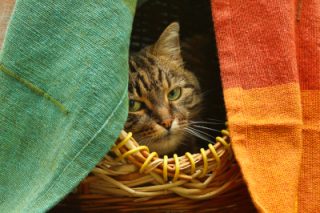
We recommend choosing ONE ROOM only as a designated “welcome room” where your cat will live exclusively during their first few days in their new home. For this reason the room should be one which can accomodate a litter tray, and where they can be securely fed.Ideally the room should allow your new cat to be kept for a period completely separate from any other existing pets.
If there are other existing pets in your home, consider making your choice of room the room that your other pets use least. Smelling the scent of other animals will indicate to your cat that they are on another animal’s territory, further heightening their sense of threat from being constrained there.
Again, cats love confined spaces so long as they have control of their entry and exit points. Being surrounded on 3 sides makes your cat feel secure that nothing can creep up on them, and yet they have the freedom to respond to any threats.
No matter how meticulous you are in preparing for and transporting your new cat or kitten, they are going to feel under threat at first in their new environment, and they are going to want to place themself in a space that feels as secure to them as possible.
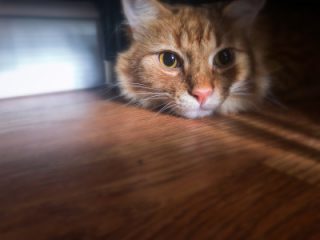
For this reason, a spare bedroom with a bed that your cat is capable of hiding under can be ideal, but if your cat is especially shy or unused to humans, bear in mind that it will be easier to interact with them if their only hiding options are more accessible spaces like cat igloos or empty boxes turned on their side.
Cats prefer sleeping spots where they can be comfortable, warm, and free from drafts. Some cats are constantly looking for new (and sometimes surprising) places to sleep. Ideally try and give them a range of different options – eg an igloo, a basket and a plush blanket, which will allow your cat to tell you their preference for bedding types.
Providing your cat with a bed can prevent them from sleeping on furniture. If you allow your cat to sleep on furniture, a washable cover, sheepskin or blanket can be placed over favorite spots to prevent the build up of fur or cat odour.
Bedrooms, studies. laundries and bathrooms are common choices for welcome rooms. Remember that the smaller the total space they are first introduced to, the less stressful the experience will be for them. Bear in mind, too that your kitty welcome room should also be a space you will feel comfortable spending time yourself during those important first days of getting to know your cat.
Spraying the space with Feliway at least 10 minutes in advance of your new cat’s arrival, and maintaining the space as per instructions will go a long way to help reduce the stressfulness of the experience for your cat or kitten.
The room should be furnished with a litter tray, food bowl and water bowl. You should try and leave any toys that you have purchased for your new kitty scattered around the room (do not leave wand toys unattended as those can be a strangulation hazard).
Even if your cat is intended to have outdoors access, we recommend planning for a period of minimum 3-4 days at the start of their transition where they spend their time exclusively in this one room. This will ensure your pet feels confident in their immediate environment before moving on to the next one.
Setting Kitty Free
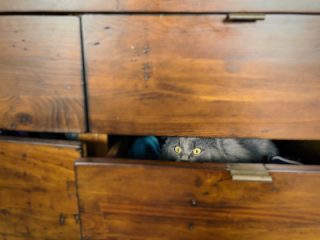
At this stage, you need to realise that you are currently a THREAT to your new cat – they don’t know how to expect you to behave towards them, and the signals you send them in these early stages are extremely important in what they learn about you and how fast they learn it.
Your cat is almost certainly going to run directly to a hiding place and remain there for some time when you first release them. Do not attempt to control this behaviour, and don’t try and extract them from their hiding place.
Do not disturb your cat while it is resting or sleeping, as waking to unfamiliar touch will induce an extreme threat response in cats and kittens. Instead making reassuring, friendly noises, such as will naturally occur if you’re making “conversation” with your cat, will signify to them that you are not a threat. Any loud or sudden noises will do exactly the opposite, so try and keep these to a minimum (even from other rooms if possible) at this time.
Do not overwhelm new cats or kittens with attention or demands. It’s not uncommon for cats to jump onto very tall furniture to explore or to feel safe. Don’t panic, don’t scream or run to the cat. When he’s ready, he’ll come down alone.

Over their first 24-48 hours most cats will progressively begin emerging from their hiding place and exploring their new environment. Don’t rush to try and pet them when they do. Let your cat come to you at their own pace, as again, most sudden movements will be perceived by your cat as threatening until they have confirmed that you are not a risk.
Let them explore their environment at their own speed, let them get used to your touch and smell progressively. We recommend placing a t-shirt or a piece of clothing that contains your scent in the welcome room.
There are as many different behaviours here as there are cats on the planet. Depending upon their backgrounds and experiences, some cats will naturally be more averse to humans than others. Some cats (particularly older and more heavily socialised animals) will quickly seek out human company in any environment, others who have more learning to do about humans in general will take a lot longer to warm up.
Try to spend several hours with your new cat on their first day so that they quickly learn you are a provider and not a threat. Supervise any children in the company of the new cat – their natural excitement will almost certainly be misinterpreted by your cat as danger.
Talk to your children about your cat’s unique psychology, and advise them to always be gentle with the cat and avoid sudden or loud movements.
In the beginning, visit your cat frequently for short periods of time. Visiting can mean interacting directly with the new cat in the form of play or petting, or quietly reading a book or chatting on the telephone in the same space as your new housemate.
A cat that is feeling threatened may show its discomfort with your presence by growling or hissing at you, twitching its tail excessively, arching its spine, pulling its ears back and exposing its teeth, and usually some combination of these. It’s most important that you DON’T respond in a way that increases the cat’s sense of threat.
Don’t make any deliberate movements towards the cat and try to avoid sudden or loud noises. The best response is to speak to them softly and reassuringly, and if possible retreat from the cat’s space or give the cat some time alone. As they come to learn that you are not a threat, this behaviour will usually fade quickly.
Beyond the Welcome Room
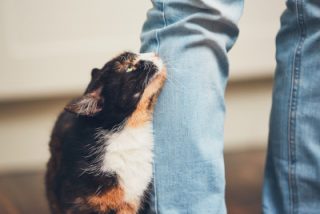
Sometimes your new cat’s integration with the rest of their new home can begin in just two to four days; however some cats may take a few weeks before they feel confident venturing further. Shyer or recently traumatised cats (and shelter environments in particular are often quite traumatising for them) in particular will tend to need a longer integration period.
Most importantly, your cat will tell you when they feel they are ready to begin getting to know the world beyond their welcome room. They will have already completely explored their immediate environment, and be showing confidence in moving around the space.
They will have begun to allow themselves to be petted, although we advise against attempting to pick your cat up too early in the process because it triggers their natural fear response at being “trapped”. This is another area where new owners’ enthusiasm, and children’s enthusiasm in particular often becomes a barrier to actually bonding quickly with them.
You may even have noticed your cat has begun rubbing itself against your legs when you enter the room – you should encourage this behaviour, as it signals they are marking YOU as safe territory.
For this reason, their chin and sides of their heads plus the base of the tail is a great place to pet your cat. Doing so engages their scent glands to mark you as non-threatening and “theirs”, and most cats have a natural tendency to respond to stimuli in these areas. They’ll let you know where it feels best to them by leaning in to your touch as your mutual bond slowly develops.
When your cat is ready to start exploring, you should also notice will begin hanging around or showing excessive interest in the door and/or windows, and stop retreating to a hiding position whenever you enter or exit.
Be sure to begin the orientation process beyond the welcome room at a time when you are home to supervise them. Close most of the doors inside your home (and double check all the external ones) so the cat begins its orientation in stages guided by you. Too many new spaces at once can be stressful and frightening, so try to block off access to as many rooms as possible as a starter.
Encouraging new cats to explore the spaces in your home where you spend a lot of time like the living room and kitchen first is a good idea, as the more time you spend in each other’s company in those early days, the quicker the bond will form. Spare bedrooms and other lesser used spaces should be opened up as special “treats” for kitty to explore once they are comfortable in your company in your usual living environment.
Follow your cat as they explore their new home, trying to stay 2-3 paces behind them so they don’t feel as though you are “stalking” them.
Marking Their Territory

As stated, cats use scent glands on their forehead, side of head, paws and near the base of their tail to mark territory, but this is not their only means of doing so.
Cats will also mark territory by scratching at objects and so activating the scent glands in their paws, or less often by urine spraying. It goes without saying that you only really want to encourage the first of these behaviours around your home.
Scratching, however, is a natural activity for cats which also serves to sharpen their claws, so it’s important that you not try to stop this behaviour altogether, you just want to make sure it is directed towards a designated scratching post rather than your precious furniture. Make sure your cat has some form of scratching device available, and ideally multiple scratchers around the home, particularly where your most prized or vulnerable furniture is located.
Stopping cats spraying is an entire other blog post in itself, but it is vital that any such behaviour is counteracted quickly if seen before it becomes an in-grained behaviour.
And allowing them to mark YOU by petting them in those sensitive areas (forehead, chin and side of head, base of tail) will help your cat bond to you quicker, again, let the petting start to happen at their own pace. They will quickly let you know if they don’t want to be touched by retreating from any invitation. It’s important that you don’t press them beyond this point, as doing so will only confirm for your cat that you represent some sort of threat to them.
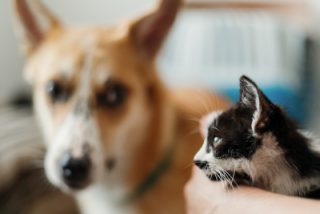
Introducing Your Cat to Existing Pets
If you need to introduce your new cat to other existing pets, you should begin a staged, slow introduction to the new animal. Again, you should try and keep the welcome room initially free of the scent of other animals to minimise the initial stress on your new cat.
Again, we cannot stress the importance of “hastening slowly” here, the risks of inducing a problem response in either animal is extremely high if you force an introduction too soon, and you will only wind up delaying or complicating the process of your pets bonding together.
Cat Meets Cat
If you’re bringing a second cat into a home with an existing adult cat already the following pointers should help secure a safe and successful introduction:
- While your newly adopted cat is settling in to their welcome room, start to introduce their smell to your existing cat. Let your cat smell your hands and clothing after you’ve been handling the new cat. Talk to them softly and pet them reassuringly.
- Feliway spray, as mentioned above is a great way to help cats de-stress through the release of natural anti-stress hormones. For this reason, setting up electronic Feliway dispensers (available from most pet stores) around your home can be an excellent way to help diffuse tensions between a new and existing cat.
- It’s a good idea if possible, once your new cat has explored one or more other areas of the house to place them securely in that area and allow your existing cat some time to explore the new cat’s welcome room.
- When you’re confident that they’re both relaxed in each other’s areas, you can start introducing your cats. Keep one cat secure in a mesh pen or carrying basket, or use heavy objects to keep the welcome room door ajar just wide enough to allow your cats to observe each other, but not wide enough to allow them to touch. Give them just a few minutes initial exposure to each other.
- Expect a certain amount of staring, hissing and ‘fluffing up’ body language as they get used to each other. This behaviour is to be expected, and you should tolerate it, but if things turn nasty and either cat makes any aggressive physical move towards trying to attack their new housemate, you should end the introduction session immediately.
- Any such problem behaviour should decline with each successive meeting, but again we urge you to proceed slowly and not force the pace of things.
- Once your cats are starting to show active interest in one another without any problem behaviours, you can start opening the door a little wider, or leaving the entrance to their carrier open to initiate first contact.
- Don’t force your cats to be too close to each other, if possible try and make the introduction in an area where your cats will have plenty of room and spots to run and retreat.
If all goes well, your two cats should become great friends, playing with each other and washing and grooming together, but be patient. This sort of relationship can take time to develop and won’t happen the first time you introduce your new kitten to your cat.
There’s a useful two-week rule of thumb when trying to build a friendship between cats. If you’ve spent two weeks following the above advice but, despite your best efforts, you still end up with two feline personalities that simply don’t mix, you should not try to force the situation further, we recommend keeping cats that are simply not bonding as separate as possible to reduce any risk of injury or violence, and ask your vet for further advice urgently.
Cat Meets Dog
Even if your existing dog is used to cats, the same may not be true in reverse, and it’s still important to take great care with introductions.
- You can begin introducing the smell of your dog to the welcome room during the induction process, although we recommend waiting 2-3 days until kitty is displaying signs of confidence in his new environment, at which time try bringing articles of your dogs bedding or their toys into the welcome room for your cat to grow acquainted with the dog odour
- Start by securing your new cat in their welcome room in a dog-proof indoor pen or cat carrier and bringing your dog in briefly on a lead.
- Have dog treats on hand to reward your dog for being calm and, even if he barks repeatedly, stay calm yourself. Your getting excited will only confirm for both pets that they should be alarmed at the situation. Remember, pets will always pick up on your stress.
- Repeat the process in a variety of rooms, making sure each time that both the cat and the dog feel safe and secure.
- Once you’re confident that they’re calm and relaxed, allow the cat to walk out of her pen or basket but keep your dog on their lead, and allow them to begin investigating one another. Continue to reward good, calm behaviour in both parties with appropriate treats. Repeat this process in as many rooms as possible.
- Supervise your pets closely at all times in each others company, and only begin to let your dog off the lead in the cat’s company once your dog has shown no inclination to try and chase or trap your cat when they move.
- Make sure your cat has somewhere ideally high up to escape to if they feel uncomfortable, out of the dog’s reach. An elevated roost is better than say a space under a bed, as climbing is one skill at which cats vastly outperform dogs. Your cat will feel wholly secure if she can climb up above anywhere that your dog has access to
- If you have more than one dog, always introduce your cat to one dog at a time.
- Separate cats and dogs at mealtimes so both can eat in comfort – you may wish to try feeding in separate rooms, or feeding your cat on an elevated surface that your dog cannot reach.
- Make sure your cat gets plenty of opportunity to chase, stalk and pounce on moving toys. Your dog is unlikely to want your cat to use their tail as a plaything.
The most important consideration when introducing a new cat to an existing cat or dog is safety. If your dog is persistently excitable or aggressive around the cat (or vice versa) speak to your vet and discuss a referral to a specialist pet behaviourist.
Your Cat’s First Vet Visit
If your cat came from a shelter, they may well have been provided some level of vaccination and worming, and you may be given a schedule on which they are recommended to next be brought to the vet. You should make sure you adhere to this schedule.
In the absence of this, kittens should receive their first vaccinations between 6-8 weeks of age, so it’s important with a young kitten to know exactly how old they are, and to get them to the vet for their first vaccination within that window. Even indoor-only cats require vaccination, and your vet will be best positioned to advise based on their circumstances.
And one final reminder that Clyde Veterinary Hospital offers free kitten (and puppy) health checks for kittens up to 10 weeks – the perfect opportunity to get your kitty’s health checked out and a tailored preventative care plan put in place. Follow the link to learn more.


